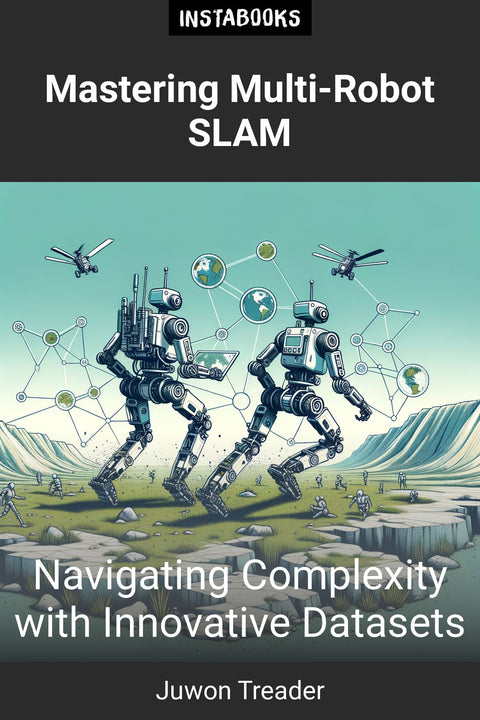
Mastering Multi-Robot SLAM
Navigating Complexity with Innovative Datasets
Included:
✓ 200+ Page AI-Generated Book
✓ ePub eBook File — read on Kindle & Apple Books
✓ PDF Print File (Easy Printing)
✓ Word DOCX File (Easy Editing)
✓ Hi-Res Print-Ready Book Cover (No Logo Watermark)
✓ Full Commercial Use Rights — keep 100% of royalties
✓ Publish under your own Author Name
✓ Sell on Amazon KDP, IngramSpark, Lulu, Blurb & Gumroad to millions of readers worldwide
Unlock the Secrets of Multi-Robot SLAM
In an era where robotics is transforming industries, the ability to navigate complex environments efficiently is paramount. This book, Mastering Multi-Robot SLAM, delves into the innovative DiTer++ dataset designed for multi-robot Simultaneous Localization and Mapping (SLAM) in challenging, real-world conditions. It offers an unprecedented exploration of how two robots can collaboratively survey environments with conflicting dynamic elements and light variations.
Challenges of Complex Environments
Readers will gain insights into the intricacies of operating in both structured and unstructured environments. This book discusses the difficulties faced when mapping areas subjected to changing lighting and shifting objects, emphasizing the necessity for adaptable approaches to maintain accuracy and reliability.
Multi-Robot Strategies for Success
Learn about the sophisticated techniques that enable multiple robots to work in harmony, overcoming obstacles while determining precise trajectories. The book emphasizes the painstaking construction of survey-grade prior maps, highlighting the process of scan-to-map matching that enhances trajectory determination.
Innovations in Technology
This book sheds light on the diverse array of sensors employed, from RGB cameras to LiDAR, showcasing how data collection through these tools allows for improved environment interaction and navigation. The role of each sensor in refining the dataset and enhancing SLAM operations is explored in detail.
Legged Robots: Traversing Diverse Terrains
An entire section is dedicated to the traversal techniques of legged robots, an essential aspect for autonomy and environmental detection. Discover the methodologies that allow these robots to adapt to a variety of terrains effectively, ensuring their longevity in diverse operational scenarios.
Accessing the Future of Robotics
The culmination of this book is not just theoretical but practical, with guidance on how to access further materials online. Readers are encouraged to explore the full DiTer++ dataset and additional resources that pave the way for ongoing research into advanced robotics.
Table of Contents
1. Understanding SLAM: Foundations and Frameworks- Key Concepts in SLAM
- Frameworks for Multi-Robot Operations
- Challenges in Data Integration
2. Introduction to DiTer++ Dataset
- Overview of the Dataset's Features
- Data Collection Methods
- Comparative Analysis with Existing Datasets
3. Mapping in Complex Environments
- Dealing with Dynamic Objects
- Variation in Lighting Conditions
- Types of Environments Explored
4. Effective Sensor Utilization
- RGB and RGB-D Cameras in Mapping
- The Role of LiDAR in Terrain Analysis
- IMU and GPS for Trajectory Accuracy
5. Survey-Grade Prior Map Construction
- Techniques for Accurate Map Creation
- Removing Dynamic Objects Effectively
- Utilizing Scan-to-Map Matching
6. Navigating with Legged Robots
- Design Challenges for Legged Robots
- Techniques for Diverse Terrain Traversal
- Autonomy and Long-term Operation
7. Data Processing for Enhanced Accuracy
- Outlier Detection Techniques
- Creating Robust Data Pipelines
- Evaluating Mapping Performance
8. Multi-Robot Coordination Strategies
- Collaborative Surveying Techniques
- Handling Communication in Real-Time
- Optimizing Data Sharing Between Robots
9. Applications of Multi-Robot SLAM
- Case Studies in Robotics Solutions
- Exploration and Mapping Scenarios
- The Future of Autonomous Robotics
10. Accessing the DiTer++ Dataset
- How to Access Dataset Materials
- Using DiTer++ for Research and Development
- Contributing to Open Robotics Resources
11. Future Directions in SLAM Research
- Emerging Technologies in Robotics
- Potential Improvements in Dataset Design
- Exploring New Applications in Robotics
12. Reviewing Existing Research and Literature
- Understanding Previous Work in SLAM
- Integrative Approaches to Multi-Robot Studies
- Continuous Learning from Historical Data
Target Audience
This book is intended for researchers, practitioners, and enthusiasts in the field of robotics, particularly those interested in multi-robot systems, SLAM techniques, and dataset design.
Key Takeaways
- Gain a deep understanding of SLAM and its key concepts.
- Explore the innovative DiTer++ dataset and its applications.
- Learn techniques for effective mapping in complex environments.
- Discover the integration of various sensors for enhanced data accuracy.
- Understand the challenges and solutions for legged robots navigating diverse terrains.
- Access practical insights for future research and development in robotics.
